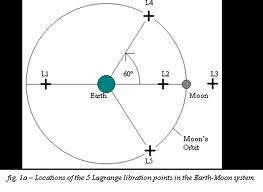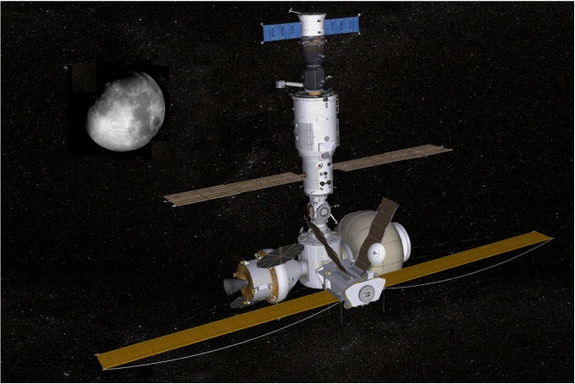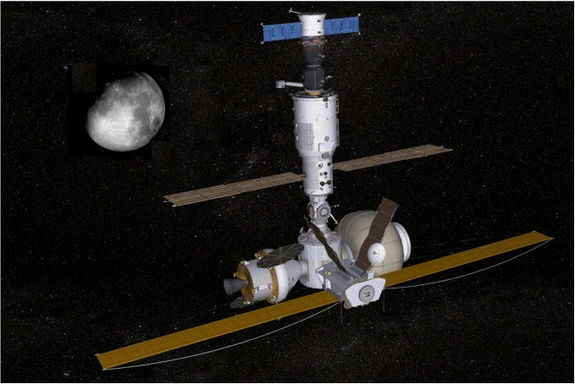A few nights ago I sat down with my wife to watch “Apollo 18.” Besides, in my opinion, being a terrible piece of filming, a disjointed script, and a storyline with holes that you could drive trucks through, it got me thinking about what we here on Earth should be doing next in space beyond low-Earth orbit. So it was a pleasant surprise to read just a few days later about some ideas being discussed at NASA that go well beyond just going back to the Moon.
There is a plan afoot for NASA to launch a new space project beyond low-Earth orbit and establish a space station at an Earth-Moon libration point. If you are unfamiliar with the term libration point, this is a location in space where the interaction of gravity exerted by the Earth and Moon cancel each other out. Also known as Lagrangian points, named after the Italian-French mathematician, Joseph Louis Lagrange, who in 1772 proposed these points in space after studying Newtonian physics, such locations are ideal as stable locations for deep space way stations. In the diagram below the locations are labelled L1, L2, L3, L4 and L5.

With NASA currently building a deep space capability with a new heavy-lift rocket, the opportunity to place a human-occupied way station in deeper space becomes more feasible. And NASA can also collaborate with commercial partners such as SpaceX or Boeing to deliver the initial materials to get the station up and operating.
Up until now the biggest challenge for space missions has been getting out of the gravity well that is Earth and the enormous costs associated with delivering large payloads into orbit. Although the Moon presents less of a challenge in terms of a launching location for deep space missions because its gravity well is not as deep as Earth’s, a space-based platform outside the pull of gravity of both would serve an even better place from which to launch deep space missions such as a voyage to Mars or an asteroid.
The libration point that best serves sits about 61,000 kilometers (38,000 miles) beyond the Moon, or 445,000 kilometers (277,000 miles) from Earth. From a way station established at this distance the Moon would be nearby. Such a station could be permanently occupied by both robotic and human crews. Robots could be deployed from here to orbit the Moon or land on the lunar surface to mine materials for use in way station construction, as well as obtain water and Helium-3. From water on the Moon the station could get needed oxygen and hydrogen. And the Helium-3 could be used as a fuel for fusion-based propulsion systems.
Other advantages to the libration point way station location include:
- It would be free of any environmental issues associated with a Moon base such as lunar dust
- It would be beyond the location where human-created or natural space junk could prove a collision hazard
- It would be in a location requiring minimal propellant to maintain its stable position
- It would serve as a test facility for a deep space habitat, a model that could be replicated for missions even further beyond the Earth-Moon system
- It would be relatively easy to reach when compared to a lunar surface habitat
- It would serve as a significant science platform within full view of both the Earth and Moon
- It would be a good assembly point for large space structures
- It would serve as a quarantine way station for missions returning from deeper space missions such as one coming back from Mars
- It would serve as a communication hub and navigation beacon for other space operations
- It would be a supply depot for human lunar activity, giving us access and communication with both the Earth-facing and far side of the Moon, and would serve as a safe haven in the event of a lunar surface mission abort
The drawbacks to such a way station include the distance should an emergency occur, and the human exposure to cosmic rays in space unprotected by Earth’s radiation belts.
The timelines: once the heavy lift rocket systems currently under development get deployed along with the Orion Multi-Purpose Crew Vehicle, scheduled to fly in 2017, planners see construction of a human outpost beyond the Moon as beginning in 2019.


















What is the boost cost per pound to L-2 or L-3?
I’m betting it’s 1,000 times greater than costs to the middle of the Sahara desert. Let NASA prove it can establish a hermetically sealed solar powered permanently manned space colony in the middle of the Sahara Desert before it starts wasting endless money on a L-2 or L-3 space colony. The technical and economic challenges of the orbiting colony would be many times greater than the Sahara colony, yet the challenges of the Sahara still seem beyond NASA’s reach. Most of the money invested in manned space projects before the development of strong natural language AI will just be wasted money. I’d support NASA funding of AI robotic systems and a sealed “space colony” in the Sahara. Give NASA $200-million to prove their concept space colony concept in the Sahara, with the understanding that the orbiting space version would likely cost one thousand times as much: $200-billion.
A joint French/Russian/Chinese heavy lift project to place millions of pounds of space junk at Earth/Moon Lagrangian points would be fine by me. Let the French/Russian/Chinese cartel enjoy all the Helium 3 they can ship back to Earth. I figure they would likely give up before they waste $200-billion, never collect the first nanogram of helium 3, and they would lag far behind US development of hermetic life support systems and strong AI. I want US space funds dedicated to Earth-based AI and hermetic life support systems. That deliberate walk-before-you-run program will put the US far ahead in any race to exploit space, and humanity in general will be the better for it.
“… the Helium-3 could be used as a fuel for fusion-based propulsion systems.”
Let’s not talk about fusion-based propulsion before we have a fusion-based reactor. The lack of a successful fusion reactor is probably the biggest engineering disappointment of the Twentieth century. Let’s talk thorium based fission reactors instead.
Is there an economic reason to use a libration point in space travel, other than the relative ease of maintaining a stable orbit there? What are the savings in time and fuel? I suppose the slingshot effect of navigating an orbit around earth or the moon would be benefical for an expedition launch.
My personal preference is to plant a rock, a very massive rock, in geosynchronous orbit as the basis for a exploratory colony. Over time we could lower a beanstalk (space elevator) until suborbital craft could navigate to a dock in low orbit, before climbing the beanstalk on electric power (solar cell collection roughly 12 hours a day).